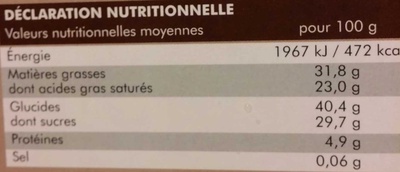Les Surgelés - Fondant au Chocolat - Lidl - 450 g
This product page is not complete. You can help to complete it by editing it and adding more data from the photos we have, or by taking more photos using the app for Android or iPhone/iPad. Thank you!
×
Barcode: 11122087
Common name: Gâteau au chocolat noir
Quantity: 450 g
Brands: Lidl
Categories: Snacks, Desserts, Sweet snacks, Frozen foods, Biscuits and cakes, Cakes, Chocolate cakes, Frozen cakes and pastries, fr:Fondant au chocolat
Manufacturing or processing places: France
Traceability code: EMB 32056 - Blanquefort (Gers, France)
Stores: Lidl
Countries where sold: France
Matching with your preferences
Environment
Carbon footprint
Packaging
Transportation
Report a problem
Data sources
Product added on by alpain
Last edit of product page on by roboto-app.
Product page also edited by beniben, jeremy64, packbot, quechoisir, segundo.
If the data is incomplete or incorrect, you can complete or correct it by editing this page.










